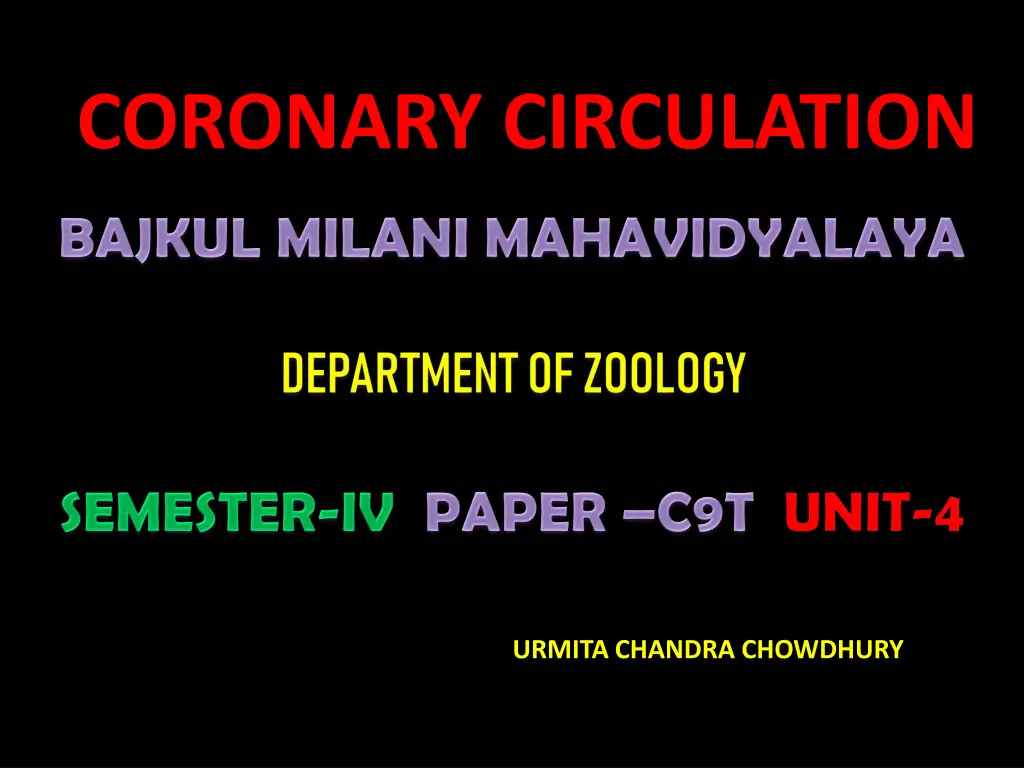
Understanding Coronary Circulation: An In-depth Overview
Explore the intricate details of coronary circulation, including the anatomy of coronary arteries, the origins of coronary ostia, and detailed descriptions of the right coronary artery. Learn about the branches, courses, and functions of the coronary system for a comprehensive understanding of cardiac blood flow.
Download Presentation

Please find below an Image/Link to download the presentation.
The content on the website is provided AS IS for your information and personal use only. It may not be sold, licensed, or shared on other websites without obtaining consent from the author. If you encounter any issues during the download, it is possible that the publisher has removed the file from their server.
You are allowed to download the files provided on this website for personal or commercial use, subject to the condition that they are used lawfully. All files are the property of their respective owners.
The content on the website is provided AS IS for your information and personal use only. It may not be sold, licensed, or shared on other websites without obtaining consent from the author.
E N D
Presentation Transcript
CORONARY CIRCULATION URMITA CHANDRA CHOWDHURY
ANATOMY OF CORONARY CIRCULATION 1. As Throughout the body, the coronary system also comprises of arteries, arterioles, capillaries, venules and veins. 2. The coronary arteries originate as the right and left main coronary arteries which exit the ascending aorta just above the aortic valve through the coronary ostia . 3. These two branches subdivide and course over the surface of the heart (epicardium ) progress inward to penetrate the epicardium and supply blood to the transmural myocardium
An Overview of the Coronary Arteries Coronary Ostia giving rise to : 1. Left Main or left coronary artery (LCA) Left anterior descending (LAD) diagonal branches (D1, D2) septal branches Left Circumflex (LCx) Marginal branches (M1,M2) 2. Right coronary artery Acute marginal branch (AM) AV node branch Posterior descending artery (PDA)
The coronary arteries originate as the right and left main coronary arteries, which exit the ascending aorta just above the aortic valve (coronary ostia). The ostiaof the left and right coronary arteries are located just above the aortic valve, as are the left and right sinuses of Valsalva.
THE CORONARY OSTIA (Origin of the coronary arteries)
Right Coronary Artery (RCA) The right coronary artery arises from the anterior sinus of Valsalvaand courses through the right atrioventricular (AV) groove between the right artium and right ventricle to the inferior part of the septum. In 60% a sinus node artery arises as second branch of the RCA, that runs posteriorly to the SA-node (in 40% it originates from the LCx).
The large acute marginal branch (AM) comes off with an acute angle and runs along the margin of the right ventricle. The RCA continues in the AV groove posteriorly and gives off a branch to the AV node. In 65% of cases the posterior descending artery (PDA) is a branch of the RCA (right dominant circulation). The PDA supplies the inferior wall of the left ventricle and inferior part of the septum.
THE LEFT MAIN CORONARY ARTERY(LMCA) The left coronary artery (left main coronary artery) emerges from the aorta through the ostia of the left aortic cusp. The left coronary artery travels from the aorta, and passes between the pulmonary trunk and the left atrial appendage. Under the appendage, the artery divides into the anterior interventricular (left anterior descending artery) and the left circumflex artery.
Branches of the left main coronary artery : Left anterior descending (LAD) artery (anterior interventricular artery) Left circumflex artery (LCX) Ramus intermedius ( between the LAD and LCX )
THE LEFT ANTERIOR DESCENDING ARTERY(LAD) The left anterior descending (interventricular) artery is a direct continuation of the left coronary artery which descends into the anterior interventriculargroove. Branches of this artery, anterior septal perforating arteries, enter the septal myocardium to supply the anterior two-thirds of the interventricularseptum (in ~90% of hearts). most of the right and left bundle branches, and the anterior papillary muscle of the bicuspid valve.
THE LEFT CIRCUMFLEX ARTERY (LCx) The circumflex artery branches off of the left coronary artery and supplies most of the left atrium. Also, posterior and lateral free walls of the left ventricle, and part of the anterior papillary muscle. The circumflex artery may continue through the AV sulcus to supply the posterior wall of the left ventricle and (with the right coronary artery) the posterior papillary muscle of the bicuspid valve.
In 40-50% of hearts the circumflex artery supplies the artery to the SA node. Branches of the circumflex :Obtuse marginal branches (OM): as it curves toward the posterior surface of the heart. 1-3 in numbers Supplies: postero-lateral left ventricle Inferior surface of left ventricle anterolateral papillary muscle Left atrium SA node(40%)
THE CARDIAC VEINS From the innumerable cardiac capillaries, blood flows back to the cardiac chambers through venules , which in turn coalesce into the cardiac veins. Most cardiac veins collect and return blood to the right atrium through the coronary sinus. Cardiac veins contain valves preventing back flow; a The besian valve may or may not cover the ostium of the coronary sinus.
MAJOR VENOUS VESSELS OF THE HEART 1. Coronary sinus 2. The anterior inter ventricular veins 3. Left marginal veins 4. Posterior veins of the left ventricle 5. The Great Cardiac Vein
THE CORONARY SINUS The coronary sinus serves as the primary collector of cardiac venous blood, located in the right atrium. The coronary sinus receives drainage from most epicardial ventricular veins, including the oblique vein of the left atrium, the great cardiac vein, the posterior vein of the left ventricle, the left marginal vein, and the posterior interventricularvein. The coronary sinus empties directly into the right atrium.
THE GREAT CARDIAC VEIN It travels in the anterior interventriculargroove beside the left anterior descending coronary artery and in the left atrioventriculargroove beside the left circumflex artery. It opens into the left extremity of the coronary sinus. It receives tributaries from the left atrium , from both ventricles and large left marginal vein.
PHYSIOLOGY OF CORONARY CIRCULATION
Coronary Blood Flow Two-thirds of coronary blood flow occurs during diastole . Five percent of cardiac output goes to the coronary arteries. Seventy percent of oxygen is extracted by the myocardial tissues of the heart, in comparison to the rest of the body at twenty five percent. During times of extreme demand, the coronary arteries can dilate up to four times greater than normal .
CORONARY BLOOD FLOW Coronary blood flow in Humans at rest is about 225-250 ml/minute, about 5% of cardiac output. At rest, the heart extracts 60-70% of oxygen from each unit of blood delivered to heart [other tissue extract only 25% of O2].
CORONARY BLOOD FLOW Why heart is extracting 60-70% of O2? Because heart muscle has more mitochondria, up to 40% of cell is occupied by mitochondria, which generate energy for contraction by aerobic metabolism, therefore, heart needs O2. When more oxygen is needed e.g. exercise, O2 can be increased to heart only by increasing blood flow.
Blood flow to Heart during Systole & Diastole During systole when heart muscle contracts it compresses the coronary arteries therefore blood flow is less to the left ventricle during systole and more during diastole. Blood flows to the subendocardial portion of Left ventricle ,which occurs only during diastole.
Phasic changes in coronary blood flow Effect of cardiac muscle contraction
Coronary blood flow to the right side is not much affected during systole. Reason---Pressure difference between aorta and right ventricle is greater during systole than during diastole, therefore more blood flow to right ventricle occurs during systole.
Effect of pressure gradient of aorta &diff chambers of heart Pressure diffrential (mmhg) Between aorta & pressure(mm hg) in Aorta Left ventricle Right ventricle Lt ventricle Rt ventricle Systole 120 121 25 -1 95 Diastole 80 0 0 80 80 As in systole pressure in left ventricle is slightly higher than in aorta blood flow reduces. On the other hand press diff in aorta & rtventricle & aorta & rt atrium is more during systole than diastole, coronary bld flow is not appreciably reduce during systole.
CORONARY BLOOD FLOW DURING SYSTOLE AND DIASTOLE
As we know during systole blood flow to subendocardial surface of left ventricle is almost not there, therefore, this region is prone to ischemic damage and most common site of Myocardial infarction.
Effect of Tachycardia on coronary blood flow: During increased heart rate, period of diastole is shorter therefore coronary blood flow is reduced to heart during tachycardia.
REGULATION OF CORONARY BLOOD FLOW RESTING CBF = 225 mL/min = 5% of total cardiac output Peak CBF early diastole ( after isovolumic relaxation) According to Poiseuille Hegan formula Blood flow (Q) = P r4/8L where P = coronary perfusion pressure r = radius , L = length of vessel = fluid viscosity
Factors Affecting Blood Flow to CORONARY ARTERIES -Pressure in aorta -Chemical factors -Neural factors -Autoregulation.
causes of decreased blood flow to left ventricle 1-Aortic stenosis Reason---As left ventricle pressure is very high during systole, therefore, it compresses the coronary arteries more. 2-When diastolic pressure in aorta is low, coronary blood flow is decreased
Chemical factors affecting Coronary blood flow Chemical factors causing Coronary vasodilatation (Increased coronary blood flow) -Lack of oxygen -Increased local concentration of Co2 -Increased local concentration of H+ ion -Increased local concentration of k+ ion -Increased local concentration of Lactate, Prostaglandin, Adenosine. NOTE Adenosine, is formed from ATP during cardiac metabolic activity, causes coronary vasodilatation.
Neural factors affecting Coronary Blood Flow 1. -Effect of Sympathetic stimulation 2. -Effect of Parasympathetic stimulation Sympathetic stimulation Coronary arteries have Alpha Adrenergic receptors which mediate vasoconstriction Beta Adrenergic receptors which mediate vasodilatation
Indirect effect of sympathetic stimulation Stimulation of sympathetic nerves release of nor adrenaline Increase of H.R &force of contraction Release of vasodilator metabolites vasodilatation
Direct effect of sympathetic stimulation When the ionotropic & chronotropic effect of noradrenergic discharge are blocked by Beta adrenergic receptor blocking drugs, stimulation of noradrenergic nerves elicits coronary vasoconstriction. Thus direct effect of noradrenergic stimulation is Vasoconstriction
Benefits of indirect effect of noradrenergic discharge When systemic B.P decreases very low reflex increase of noradrenergic discharge Increase c.b.f sec to metabolic changes in myocardium In this way circulation of heart is preserved while flow to other organs compromised
Effect of Parasympathetic stimulation -Vagus nerve stimulation (Parasympathetic) causes coronary vasodilatation.
FACTORS AFFECTING CORONARY BLOOD FLOW 1. Mean aortic pressure. 2. Muscular exercise. 3. Emotional excitement. 4. Hypotension. 5. Hormones affecting CBF. 6. Heart rate. 7. Effect of ions. 8. Metabolic factors. 9. Temperature.
CORONARY ARTERY DISEASE Coronary artery disease(CAD) also known as ischaemic heart disease(IHD) results due to insufficient coronary blood flow. Causes of CAD include:---- Atherosclerosis of coronary arteries, Thrombus formation, Embolus coming from other areas, and Spasm of coronary vessels. since atheromatous coronary artery stenosis is the commonest cause,so it has become synonymous with CAD.




